How do I choose the right cylinder heads for my engine?
It’s a simple question but the actual answer is more complicated than you’d think. There are many factors involved in choosing the optimum cylinder heads for a specific application, including:
- Engine displacement
- Type of vehicle
- Intended use
- Desired compression ratio
- Gear size
- Other performance modifications
For this two-part series, we’ve enlisted the help of aftermarket giants Edelbrock, Trick Flow Specialties, and Summit Racing for advice on choosing off-the-shelf aftermarket cylinder heads. We’re going to cover some of the most common mistakes people make when shopping for cylinder heads in this installment. Once you understand why it’s important to avoid these pitfalls, we’ll give you some tips and guidelines for choosing a set of cylinder heads for your application.
Whatever your application, here are common mistakes to avoid when selecting new cylinder heads.
Missing the Big Picture
Cylinder heads are just one part of the entire performance package.
They’re not a standalone upgrade in that they must be matched to your cam profile, desired compression ratio, and all other factors we listed above to work in your engine’s optimum operating range. Therefore, depending on the other pieces of the performance puzzle (camshaft, pistons, intake manifold, etc.), there’s really not a one-size-fits-all solution.
“Whether it’s a daily driver, Saturday night special, or real competition car, the heads and all the associated components need to match,” said Edelbrock design engineer Matt Gamble. “It’s the total engine package that matters. That’s why we offer our Power Packages—to take some of the guesswork out of matching up all of these components. And if someone is looking to buy just the cylinder heads, they can also look at how we’ve put these packages together as sort of a guideline for what they need.”
Based on your vehicle and intended use, you should have a goal in mind for the performance you want—and then stick with it. According to Carl Pritts, a tech advisor at Summit Racing, people often build engines little by little as their budget allows. Pritts says the goals for the engine can change over time, and that can lead to problems.
“They should stick to the original goal set when they started buying or stockpiling parts,” Pritts said. “Otherwise, it ends up being mismatch city!”
The bottom line is it’s important to think big picture by taking into account the goal of the project as well as potential future modifications.
Going Bench Racing
A lot of consumers focus on airflow numbers when choosing cylinder heads.
These numbers are derived from flow bench testing, and manufacturers most often advertise airflow at peak lift because these tend to be the highest numbers. Although impressive, these numbers often don’t translate from the flow bench to real-world performance, especially in street performance applications.
For example, a cylinder head may deliver impressive numbers at .700-inch lift; however, a street engine doesn’t typically provide that much. It is more practical and beneficial to look at the airflow numbers in the .200- to .500-inch lift range. For this reason, many manufacturers, including Edelbrock, offer airflow charts with flow numbers at various lift levels.
“People tend to look at the number at peak lift,” Gamble said. “That’s usually measuring airflow at a number that’s not going to be run with that engine so looking at the entire range of numbers is key. You want to look at the area under the entire flow curve.”
Flow bench numbers don’t necessarily translate into actual real-world performance either.
“When you flow a cylinder head on a flow bench, you’re at a steady state of depression, which is the measurement of how hard it’s pulling on that cylinder head,” said Trick Flow engineering supervisor Cory Roth. “The industry standard is typically 28 inches, but that’s a static figure that was brought up years back when they were first developing flow benches and trying to figure out how to correlate cfm on a flow bench to horsepower on a dyno. On an actual engine, that number could start at a couple inches and could up to 40 inches and vary in between as the piston goes up and down.”
Bottom line is there can be a disconnect between airflow and actual performance.
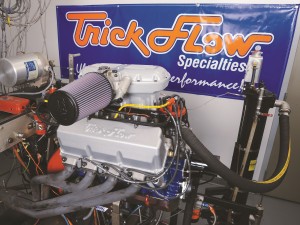
Dyno-testing is an essential part of the cylinder head testing at Trick Flow and many other top head manufacturers.
“We had a set of heads on the dyno—our 195cc (Ford) 4.6 heads and it flowed very well but the power wasn’t what we expected,” Roth said. “We had changed the intake port shape while maintaining the same volume and actually lost some flow in the lower lifts. We changed the combustion chamber shape, and that same head made 18 more horsepower, even though the flow bench said it wasn’t as good as the earlier design.”
That’s why companies like Edelbrock and Trick Flow don’t limit testing to the flow bench.
“You can test on a flow bench, but eventually you’ve got to do some testing on an engine for that final answer,” Gamble said.
Simply put, flow bench numbers can provide a good idea about a cylinder head’s power potential, but they aren’t the end all be all.
Bigger is Better Mentality
Whoever said “bigger is not always better” was clearly referring to cylinder head intake ports.
Still, there’s a tendency among performance enthusiasts to choose intake ports that are larger than they really need. “When they show up to cruise night, I think everyone wants to say they have the biggest stuff out there—the biggest heads with the biggest valves and biggest compression,” Gamble said. “They need to put the brakes on!”
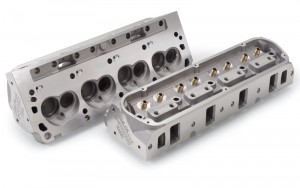
Following the idea that smaller port volumes produce more torque and better throttle response, Edelbrock E-Street heads have intake ports designed to create more usable power on the street.
As a rule of thumb, smaller intake port volumes will produce more low-end torque and crisper throttle response, while larger intake ports allow more flow at higher rpms. Therefore, smaller intake ports often deliver better results for street performance and part-time race vehicles, and larger ports would likely cause the torque numbers to fall off. On the other hand, larger intake runners could benefit higher-revving or larger displacement engines.
The port volume is determined by the length of the port and Cross-Sectional Area (CSA). Matching the correct CSA to the engine’s demand is the key. The properly sized intake runner will create the right balance between airflow volume and airflow velocity, and it’s not always the biggest runner that wins.
“We usually recommend the smallest port volume with the highest efficiency,” Gamble said. “This means there’s good velocity through the port and the ability to fill the cylinder.”
Gamble also points out that certain design elements within the intake runners have allowed for increased efficiency in recent years.
“You’ve probably heard of swirl and tumble,” he said. “These designs affect mixture motion by either swirling the air or causing the incoming air to tumble as it enters the cylinder. This helps with combustion and cylinder filling by directing the air and keeping it suspended and moving around in the combustion chamber until burned.”
The bottom line is bigger isn’t always better.
“A lot is tied to camshaft and rpm band, but people need to think about velocity through the port,” Gamble said. “For street applications, we offer intake ports with a smaller cross-sectional area and throat size which are appropriate for the engine’s needs.”
Ignoring the Exhaust
The intake side of the cylinder head tends to get the most attention.
“I’m not sure why, but people disregard the exhaust side…perhaps because the peak flow number is not as big and doesn’t hold the same glory as the intake,” Gamble said. “But once you’ve got the air/fuel charge into the cylinder, compressed it, combusted it, and extracted work from it, you have to get it out of the cylinder so the cycle can repeat. Doing it in the most efficient manner possible is the goal.”
A cylinder head with great intake airflow numbers but poor exhaust flow will not perform as well as a head with a slightly lower-flowing intake port and excellent exhaust port. With a good-flowing exhaust, you will see good power.
There are ways to combat poor exhaust flow, including the use of higher-lift, higher-duration camshafts to keep the exhaust valve open longer. However, for maximum airflow, the ideal situation is to have a strong-flowing port to expel the spent gases and make room for a fresh, new intake charge in the cylinder.
According to Gamble, exhaust port size should be chosen in a manner similar to the intake side. The port volume will depend on the size of the valve and length of the port, but the stock exhaust port volume and valve size can be used as a reference point for comparing aftermarket heads to stock heads. These stock numbers can be found online for most engines, and flow numbers can be compared directly if valve sizes are the same.
“I like exhaust ports with a small cross-sectional area and high flow,” Gamble said. “Given the choice between a large volume port and small volume port that flows the same with the same valve size and port length, go with the small volume port. A good, high-flowing, efficient exhaust port will unlock horsepower in the upper rpm range.”
As engine performance level increases, there are other exhaust size options to consider.
“There are options for stock or raised ports in many heads,” Gamble said. “The advantage is that the port starts to get straighter. Straightening out the port will tend to lead to less pressure loss through the port (higher flow). As engine performance levels increase, more exhaust flow is needed to match greater intake flow and power levels and raising the ports plays an important role in achieving this goal.”
Gamble is quick to point out that a raised port will almost always require a different header setup, and chassis clearance can also be an issue depending on application.
Failing Combustion Chamber Geometry
Believe it or not, combustion chamber design is an afterthought for many people.
“One of the more important aspects that’s often overlooked when selecting a set of cylinder heads is combustion chamber design and size,” said Summit Racing’s Mike Bosiljcic. “There are a lot of aspects that follow along with the combustion chamber that determine how that cylinder head is going to perform on your engine, how it’s going to fit, and whether it’s going to work.”
Combustion chamber size and design plays a huge role in performance, but it all has to work in concert with other engine components. We call this balance “combustion chamber geometry.”
“Compression ratio is the driver of combustion chamber size,” Gamble said. “One needs to determine the chamber size needed based on the specs of the engine. Bore, stroke, head gasket, piston shape, deck clearance, and ring location all come into play in determining the compression ratio for a given chamber size. Raising compression ratio as far as the fuel and mechanical components will allow will help maximize the efficiency of the engine…but the chamber size needs to be matched up to the other components in the engine I already mentioned. The customer needs to determine what components they have, what performance level they are trying to reach, and what fuel they wish to run.”
Smaller combustion chambers allow you to create a higher compression ratio; however, they can also create clearance issues with pistons and valves. Conversely, larger combustion chambers will accommodate larger dome-style pistons. You need to consider the components you’re using in conjunction with your cylinder heads when choosing a chamber size. And that can take planning.
It’s also important to consider combustion chamber shape and how it works with chamber size.
“The shape will definitely affect performance,” Gamble said. “The chamber can be considered as the last part of the intake flowpath and the first part of the exhaust flowpath. I spend a lot of time during the design phase working on integrating this shape with the ports while still maintaining the combustion chamber volume I am trying to achieve. This can be a bit of a balancing act, to get the flow, the mixture motion, the plug location, the valve location, the valve sizes, seat sizes, etc. to all work together to create the proper sized chamber that will aid in good combustion.”
This has led to a drastic change in chamber design over the years. We’ve seen the old D-shaped chambers replaced in favor of heart-shaped chambers or other designs. The idea behind these designs is to relocate the spark plug toward the center of the cylinder and promote better flame travel.
“Heart-shaped chambers direct incoming fuel into the cylinder and helps with cylinder filling,” Gamble said. “Ideally, we want to avoid hot spots and locate the plug in a way that aids in optimum combustion.”
Trick Flow follows those same principles when designing cylinder heads.
“Trick Flow is known for our willingness to move things around to achieve more airflow and horsepower,” Roth said. “The LS3 factory head, for example, has a very wide valve spacing and both valves are shrouded. So we moved the intake toward the center of the bore to unshroud it, and that’s one of the reasons why our heads really flow.”
Roth says he’s seen an added benefit to newer chamber designs.
“What you’ll find in more efficient chamber designs is you can run a lot lower initial timing compared to heads that have the plug a lot further from the center of the cylinder,” he said. “I think that’s why you can run pump gas with higher compression these days…because of advances in combustion chamber design.”
CNC profiling has also become a popular option in recent years. According to Bosiljcic, the chamber profiling ensures smooth chamber walls to promote better flame travel. At the same time, it prevents hot spots by eliminating pockets in the chamber surface that allow carbon to build up within the cylinders.
Super-Sizing the Valves
“Super-sizing” may be a bit of an exaggeration, but cylinder head buyers have been known to opt for valves that are too large. That can result in cylinder heads that don’t fit an engine’s performance needs—or the actual engine itself!
“‘Bolt-on’ installation doesn’t necessarily mean a set of cylinder heads will work,” Bosiljcic said.
Summit Racing customers sometimes bolt on a set of heads and then find out the engine won’t rotate, he said. This is very often because the valves are too large for that engine and literally collide with the pistons or cylinder walls. Certain engines aren’t designed to work with valves larger than a particular size. For example, a small bore, small block Chevy like the 283 or 305 can’t accept something like a 2.02-inch intake valve without relieving the cylinders.
Furthermore, you don’t always need larger valves for optimum performance.
For the same reasons bigger isn’t always better for intake ports, bigger valves aren’t always the right choice for certain engines. Smaller valve diameters tend to create greater air intake velocity at lower rpm. That fosters greater torque and power at lower rpm—right where street applications can use it the most. Larger valves, on the other hand, let your engine breathe at higher rpm, making them ideal for highly modified or race applications.
According to Roth, large valve diameter doesn’t even guarantee maximum airflow.
“A larger valve usually winds up running closer to the cylinder wall,” Roth said. “When we were developing our (Ford) 4.6 CNC head, we found our restriction was the cylinder wall itself. Every time we put a bigger valve in it, we couldn’t get the valve and port to flow like we thought they should. Once we backed our valve size off, it started to flow better.”
The angle and location of the valves, along with things like cylinder head port size and camshaft profile, factor into how much air a cylinder head flows. This takes us back full circle to our very first point: Cylinder heads are just part of the big picture.
In Head Start (Part 2), we’ll apply some of the information learned here to help you choose the right cylinder head for your engine and vehicle.

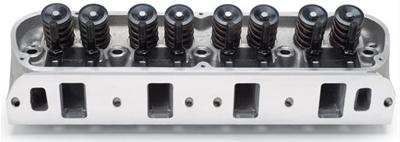
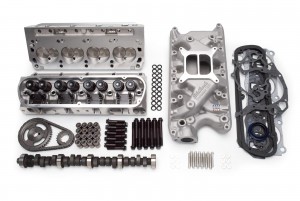
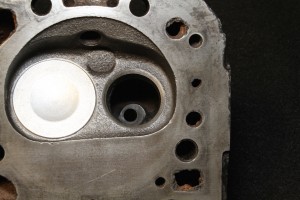
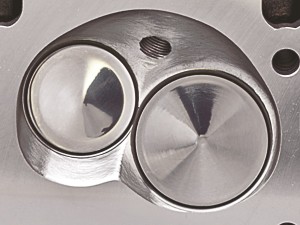
[…] Read More […]
[…] […]
This is some really good information about gas cylinders. It does seem like a good idea to know if you are going to be using a cylinder head. I didn’t realize that the shape of the head can really effect how they work.
Excellent article so far, but can I ask who I can go to to for some truthful answers on having the heads on my Range Rover 4.6 liter V8 (Gems EFI) to improve fuel consumption and give a little more power.
Can you advise the pros and cons of purchasing a bare aluminum cylinder head versus a fully assembled head? Assuming the buyer will be changing the valve spring on an assembled head that matches their cam specifications. Would assembling a head yourself mean, you may get better parts?
My 2002 Kawasaki ZX9R head is of a DOHC design with canted valves but the Kawasaki design engineers dropped the ball when the designed the port configuration on both intake and exhaust, especially the exhaust port where they put a curve, to make more room for the OEM primarily pipes and give more room for the radiator.
I firmly believe these could. Be killer heads by raising both the top of intake and exhaust. weld up the port floor for better flow. and equalize the port volumes
So in a chevy BB is closed or open heads better for take off speed and performance
Do you sell any heads for a 3.8l Ford Mustang 2000 V6
Hey Chris,
The only ones I found were OE stock replacement heads from VEGE. Check ’em out here.
[…] cylinder heads from ADV Cylinder Heads are designed for 2002-2006 power stroke vehicles. They come with many unique features that you must […]
i need summit raceing to set me up with upper end combo for 1965 ford 289 with 10.5.1 pistons[ completeheades,intake,rocker arms push rods ,cam and lifters,carb. exhaust manifolds Thank You
Hey William, click here to contact Summit Racing–they’ll help fill in the blanks to make sure you get exactly what you’ll need.
Looking for a nice set of alum. heads for my SBC 383 I’m building , just for playing around on the Street. Running it in my 1955 Chey
Looking for a nice set of alum. heads for my SBC 383 I’m building , just for playing around on the Street. Running it in my 1955 Chey Running 268 Comp Cam